Genomic analysis of blaNDM-1-carrying-Pseudomonas aeruginosa ST2407 in the chromosome from Brazil
IF 2.6
4区 医学
Q3 INFECTIOUS DISEASES
引用次数: 0
Abstract
Pseudomonas aeruginosa, an opportunistic pathogen often found in Healthcare-associated infections (HAI), has shown increased resistance to carbapenems (imipenem, meropenem, doripenem), the primary treatment options. We've seen a rise in carbapenemase-producing P. aeruginosa in Brazil, including NDM-producers. This study characterises an isolate carrying blaNDM-1 from a patient's skin fragment in a Brazilian hospital. The whole genomic sequence (WGS) of P. aeruginosa CCBH26428 was extracted and sequenced using Illumina and minION platforms. The assembly used MinION results mapped with Illumina reads, and annotation was performed by the RAST server. Resistance genes and clonality were identified using the CABGen platform. Additional information was carried out by manual annotation using Geneious software and BLAST tool. The genomic analysis revealed a genome of 6.995.008 bp and G+C 65.9 %. P. aeruginosa CCBH26428 belongs to ST2407. The blaNDM gene, associated with ISAba125, was found in a 63.862 pb genomic region flanked by IS26 insertion sequences. This region also contained the repA of the plasmid incompatibility group IncC2 and other resistance genes, suggesting it is a possible “translocation unit”. Additionally, 17 resistance genes, mutations in OprD and GyrA, and several virulence genes were detected, potentially exacerbating the infection. This study is report a WGS analysis of P. aeruginosa carrying blaNDM-1 in Brazil, highlighting the role of IS26 in the acquisition and spread of resistance genes between plasmids and chromosomes.
巴西携带blandm -1铜绿假单胞菌ST2407染色体的基因组分析。
铜绿假单胞菌是一种常见于医疗保健相关感染(HAI)的机会性病原体,对主要治疗方案碳青霉烯类(亚胺培南、美罗培南、多利培南)的耐药性增强。我们在巴西看到了碳青霉烯酶生产铜绿假单胞菌的增加,包括ndm生产商。本研究从巴西一家医院的患者皮肤碎片中分离出携带blaNDM-1的分离物。利用Illumina和minION平台提取铜绿假单胞菌CCBH26428的全基因组序列(WGS)并进行测序。组装使用MinION结果与Illumina reads映射,并由RAST服务器进行注释。利用CABGen平台鉴定抗性基因及其克隆性。附加信息采用geneous软件和BLAST工具手工标注。基因组分析显示基因组为6.995.008 bp, G+C为65.9% %。P. aeruginosa CCBH26428属于ST2407。与ISAba125相关的blaNDM基因位于IS26插入序列两侧的63.862 pb基因组区域。该区域还含有质粒不相容组IncC2的repA等抗性基因,提示其可能是“易位单元”。此外,检测到17个耐药基因、OprD和GyrA突变以及几个毒力基因,可能加剧感染。本研究报告了巴西携带blaNDM-1的铜绿假单胞菌的WGS分析,强调了IS26在质粒和染色体之间抗性基因的获取和传播中的作用。
本文章由计算机程序翻译,如有差异,请以英文原文为准。
求助全文
约1分钟内获得全文
求助全文
来源期刊

Infection Genetics and Evolution
医学-传染病学
CiteScore
8.40
自引率
0.00%
发文量
215
审稿时长
82 days
期刊介绍:
(aka Journal of Molecular Epidemiology and Evolutionary Genetics of Infectious Diseases -- MEEGID)
Infectious diseases constitute one of the main challenges to medical science in the coming century. The impressive development of molecular megatechnologies and of bioinformatics have greatly increased our knowledge of the evolution, transmission and pathogenicity of infectious diseases. Research has shown that host susceptibility to many infectious diseases has a genetic basis. Furthermore, much is now known on the molecular epidemiology, evolution and virulence of pathogenic agents, as well as their resistance to drugs, vaccines, and antibiotics. Equally, research on the genetics of disease vectors has greatly improved our understanding of their systematics, has increased our capacity to identify target populations for control or intervention, and has provided detailed information on the mechanisms of insecticide resistance.
However, the genetics and evolutionary biology of hosts, pathogens and vectors have tended to develop as three separate fields of research. This artificial compartmentalisation is of concern due to our growing appreciation of the strong co-evolutionary interactions among hosts, pathogens and vectors.
Infection, Genetics and Evolution and its companion congress [MEEGID](http://www.meegidconference.com/) (for Molecular Epidemiology and Evolutionary Genetics of Infectious Diseases) are the main forum acting for the cross-fertilization between evolutionary science and biomedical research on infectious diseases.
Infection, Genetics and Evolution is the only journal that welcomes articles dealing with the genetics and evolutionary biology of hosts, pathogens and vectors, and coevolution processes among them in relation to infection and disease manifestation. All infectious models enter the scope of the journal, including pathogens of humans, animals and plants, either parasites, fungi, bacteria, viruses or prions. The journal welcomes articles dealing with genetics, population genetics, genomics, postgenomics, gene expression, evolutionary biology, population dynamics, mathematical modeling and bioinformatics. We also provide many author benefits, such as free PDFs, a liberal copyright policy, special discounts on Elsevier publications and much more. Please click here for more information on our author services .
 求助内容:
求助内容: 应助结果提醒方式:
应助结果提醒方式:


